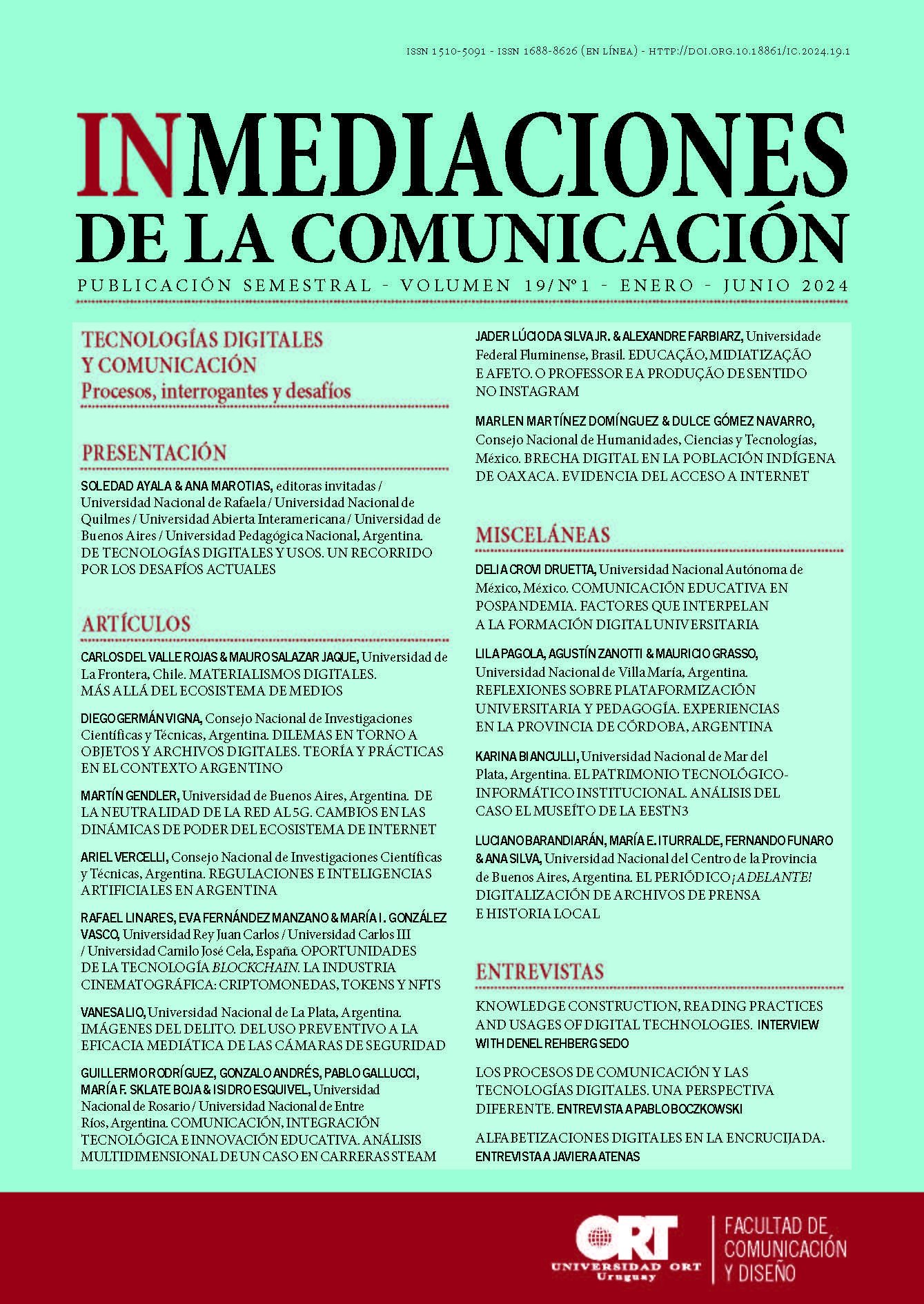Opportunities of blockchain technology
The Film Industry: Cryptocurrencies, tokens, and NFTs
DOI:
https://doi.org/10.18861/ic.2024.19.1.3457Keywords:
blockchain, criptocurrency, NFTs, crowdsourcing, films, film industryAbstract
For some time now, the film industry has been generating new processes in the value chain thanks to the emergence of new technologies such as blockchain. Blockchain technology comes from the IT field and is analysed in this article with the aim of identifying and reflecting on the new business models that this technology entails. In this sense, it analyses how NFTs (Non-Fungible Tokens), unique digital media regulated precisely through blockchain technology, are breaking into artistic and cinematographic creation formats, thereby reaching new audiences. This raises controversies regarding intellectual property and its subsequent management. As a result of the research carried out, with a positive assessment and an openness to new forms of production, it was discovered that the emergence of new processes requires some time for assimilation, while transparency in management, the degree of knowledge and handling of technology and mistrust are aspects observed among users.
Downloads
References
Anderson, C. (2006). The Long Tail. New York: Hyperion.
D’Alessandro, A. (2021). Kevin Smith To Sell Horror Movie ‘Killroy Was Here’ As NFT, Launches Jay And Silent Bob’s Crypto Studio. Deadline. Recuperado de: https://deadline.com/2021/04/kevin-smith-killroy-was-here-nft-sale-jay-and-silentbob-crypto-studio-1234733439/.
Dutra, A., Tumasjan, A. & Welpe, S. (2018). Blockchain is changing how media and entertainment companies compete. MIT Sloan Management Review. Recuperado de: https://sloanreview.mit.edu/article/blockchain-is-changing-how-mediaand-entertainment-companies-compete/.
Estellés Arolas, E. & González Ladrón de Guevara, F. (2012). Clasificación de iniciativas de crowdsourcing basada en tareas. El profesional de la información, 21(3), pp.283-291. DOI: http://dx.doi.org/10.3145/epi.2012.may.09.
Hernández, J. A. (2015). Así descubrieron los inspectores de cultura el fraude del taquillazo. El País. Recuperado de: https://elpais.com/cultura/2015/11/30/actualidad/1448914417_809443.html
Howe, J. (2006). The rise of crowdsourcing. Wired. Recuperado de: http://www.wired.com/2006/06/crowds.
Howe, J. (2008). Crowdsourcing: why the power of the crowd is driving the future of business. New York: Crown Business.
Jenkins. H. (2008). Convergence culture. Barcelona: Paidós.
Kotler, P., Kartajaya, H. & Setiawan, I. (2021). Marketing 5.0. Hoboken: Wiley.
Kugler, L. (2021). Non-fungible tokens and the future of art. Communications of the ACM, 64(9). DOI: https://doi.org/10.1145/3474355.
Lamport, L., Shostak, R. & Pease, M. (1982). The Bizantine General Problem. ACM Transactions on Programming Languages and Systems, 4(3), pp. 382-401. DOI: https://doi.org/10.1145/357172.357176.
Lee, X., Yang, X. & Kim, X. (2021). Blockchain-Based Smart Propertization of Digital Content for Intellectual Rights Protection. Electronics 10(12). DOI: https://doi.org/10.3390/electronics10121387.
Liu, L., Zhang, W. & Han, C.(2021).A survey for the application of blockchain technology in the media. Peer-to-Peer Networking and Applicattions, 14, pp. 3143-3165. DOI: https://doi.org/10.1007/s12083-021-01168-5.
Makridakis, S. & Christodoulou, K. (2019). Blockchain: Current Challenges and Future Prospects/Applications. Future Internet, 11. DOI: https://doi.org/10.3390/fi11120258.
Nadini, M., Alessandretti, L., & Di Giacinto, F., Martino, M., Aiello, L. & Baronchelli, A. (2021). Mapping the NFT revolution: market trends, trade networks, and visual features. Scientific Reports, 11. DOI: https://doi.org/10.1038/s41598-
-00053-8.
Nakamoto, S. (2008). Bitcoin: A Peer-to-Peer Electronic Cash System. Recuperado de: https://web.archive.org/web/20161213081707/http://article.gmane.org/gmane.comp.encryption.general/12588/.
Patrickson B. (2021). What do blockchain technologies imply for digital creative industries? Creativity and Innovation Management, 30(3), pp. 585-595. DOI: https://doi.org/10.1111/caim.12456.
Pennington, A. (2021). Blockchain and NFTs: Power to the producer. Streaming Media Magazine. Recuperado. de: https://www.streamingmediaglobal.com/Articles/ReadArticle.aspx?ArticleID=150550
Van Haaften-Schick, L. & Whitaker, A. (2020). From the Artist’s Contract to the Blockchain Ledger: New Forms of Artists’ Funding Using NFTs, Fractional Equity and Resale Royalties. Journal of Cultural Economics, 46(3), pp. 287-315. DOI:






